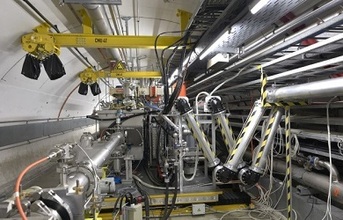
Test bench of the first two prototype crab cavities in the Super Proton Synchrotron (SPS) accelerator. The cryomodule containing the cavities is installed on a mobile table that allows it to be moved into the beam line as needed. (Image: M. Brice/CERN)
The two first crab cavity prototypes were manufactured at CERN in 2017 in collaboration with Lancaster University and the Science and Technology Facilities Council (STFC) in the United Kingdom, as well as the U.S. LHC Accelerator Research Program (USLARP). The cavities were assembled in a cryostat and tested at CERN. They are made of high-purity niobium superconducting material, operating at 2 kelvins (-271°C), in order to generate very high transverse voltage of 3-4 million volts. The cavities were installed in the SPS accelerator during the last winter technical stop to undergo validation tests with proton beams.
The first beam tests on 23 May lasted for more than 5 hours at a temperature of 4.2 K with a single proton bunch accelerated to 26 GeV and containing between 20 and 80 billion protons, almost the intensity of the LHC bunches. The crab cavities were powered to about 10% of their nominal voltage. The "crabbing" was observed using a special monitor to observe the tilt along the length of the bunch. "These tests mark the start-up of a unique facility for testing superconducting cavities on a high-current, high-energy proton beam," explains Lucio Rossi, leader of the HL-LHC project. "The results are impressive and crucial to prove the feasibility of using such cavities for increasing the luminosity in the LHC."
In the coming months, the cavities will be commissioned to their nominal voltage of 3.4 million volts and will undergo a series of tests to fully validate their operation for the HL-LHC era. A total of 16 such cavities will be installed in the HL-LHC - eight near ATLAS and eight near CMS.
END


























